| The patterns on some of the older Chinese rugs are often taken from the patterns of the porcelain painters and from silks. |
China has a long tradition of rugs and the original ones, probably used as merchandise, are dated at over 2.000 years ago, and were used as carpets for the imperial courts. The art of knotting rugs was however, introduced somewhere around the 15th and 17th century in China.
 The patterns on some of the older Chinese rugs are often taken from the patterns of the porcelain painters and from silks. In some cases the patterns also show old religous symbols with distinguished dragon patterns. The symbols in these rugs ocassionally have taostic or buddhistic origins.
The patterns on some of the older Chinese rugs are often taken from the patterns of the porcelain painters and from silks. In some cases the patterns also show old religous symbols with distinguished dragon patterns. The symbols in these rugs ocassionally have taostic or buddhistic origins.
Thin warp yarns of cotton can often be found in the elderly rugs, which together with rough pile yarn gives large knots and rugs that are fairly thick, but also soft and flexible. These rugs are manufactured in the provinces of Kansu, Ningxia, Suiyan and in Inner Mongolia near the city of Baotou (Baotou carpets, often in small sizes, characterized by landscape and symbolic motifs with blue in different nuances as a dominating colours) . Later on Shansi-, Hopei- and Shantung provinces were added as some of the manufacturing provinces.
On younger and newly manufactured rugs, a variety of different patterns occur, for example flowers. A large part of the newer rugs are thick and compact due to the double warp that is used (two layers of yarns) and the technique of the knots are senneh asymmetrical. The production of these rugs today are made in the cities of Beijing and Tianjin and its surroundings.




